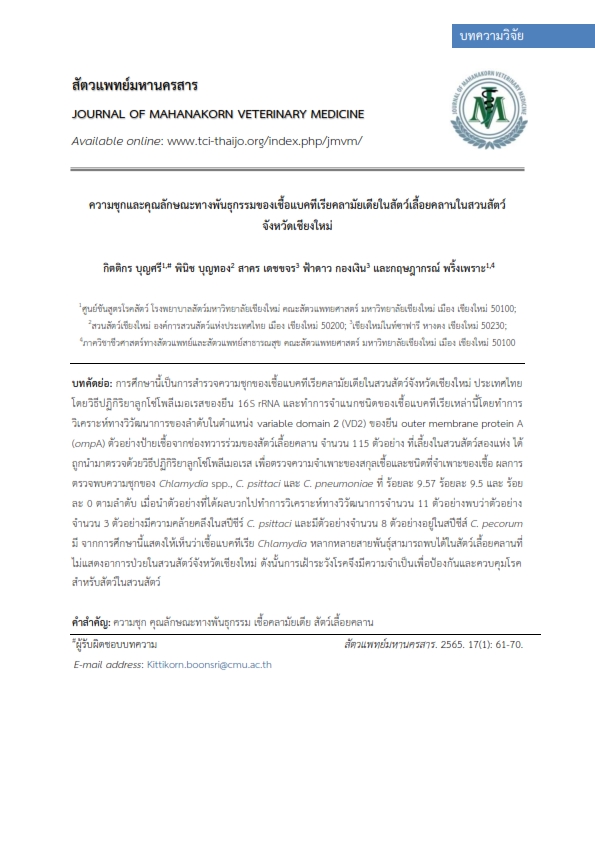Prevalence and Genetic Characterization of Chlamydia spp. in Captive Reptiles in Zoos, Chiang Mai
Main Article Content
Abstract
This study investigated the prevalence of chlamydia among captive reptiles in zoos, Chiang Mai, Thailand. The method was conducted by polymerase chain reaction (PCR) of the 16S rRNA gene and further characterized these bacteria by performing phylogenetic analysis of the sequences of the variable domain 2 (VD2) region of the ompA gene, with encodes the Chlamydia major outer membrane protein. Cloacal swabs were collected from 115 reptile animals in two zoos and examined for their genus and species specification. The prevalence of Chlamydia spp., C. psittaci and C. pneumoniae were found to be 9.57%, 9.57% and 0%, respectively. Phylogenetic analysis from 11 samples showed that three samples were similar to C. psittaci and eight samples were C. pecorum. This study demonstrated for the fixed time that diverse Chlamydia species could be found in asymptomatic reptiles in zoos of Chiang Mai province. Therefore, disease monitoring is necessary to prevent and control clamydiosis in zoo animals.
Article Details

This work is licensed under a Creative Commons Attribution-NonCommercial-NoDerivatives 4.0 International License.
References
Beeckman, D.S. and Vanrompay, D.C. 2009. Zoonotic Chlamydophila psittaci infectious from a clinical perspective. Clin. Microbiol. Infect. 15(1): 11-17.
Bodetti, T.J., Jacobson, E., Wan, C., Hafner, L., Pospischil, A., Rose, K. and Timms, P. 2002. Molecular evidence to support the expansion of the host range of Chlamydia pneumoniae to include reptiles as well as humans, horses, koalas and amphibians. Syst. Appl. Microbiol. 25: 146-52.
Gaydos, C.A., Roblin, P.M., Hammerschlag, M.R., Hyman, C.L., Eiden, J.J., Schachter, J. and Quinn, T.C. 1994. Diagnostic utility of PCR-enzyme immunoassay, culture, and serology for detection of Chlamydia pneumoniae in symptomatic and asymptomatic patients. J. Clin. Microbiol. 32: 903-5.
Grayston, J.T., Campbell, L.A., Kuo, C.C., Mordhorst, CH., Saikku, P., Thom, D.H., Wang, S.P. 1990. A new respiratory tract pathogen: Chlamydia pneumoniae strain TWAR. J. infect. Dis. 161: 618-25.
Jackson, M., White, N., Giffard, P. and Timms, P. 1999. Epizootiology of Chlamydia infections in two free-range koala populations. Vet. Microbiol. 65: 255-64.
Kabeya, H., Sato, S. and Maruyama, S. 2015. Prevalence and characterization of Chlamydia DNA in zoo animals in Japan. Microbiol. Immunol. 59: 507-515.
Kaltenboeck, B., Heard, D., DeGraves, F.J., Schmeer, N. 1997a. Use of synthetic antigens improves detection by enzyme-linked immunosorbent assay of antibodies against abortigenic Chlamydia psittaci in ruminants. J. Clin. Microbiol. 35: 2293-2298.
Myers, G.S., Mathews, S.A., Eppinger, M., Mitchell, C., O’Brien, K.K., White, O.R., Benahmed, F., Brunham, R.C., Read, T.D., Ravel, J., Bavoil, P.M. and Timms, P. 2009. Evidence that human Chlamydia pneumoniae was zoonotically acquired. J. Bacteriol. 191: 7225-33.
Messmer, T.O., Skelton, S.K., Moroney, J.F., Daughrty, H. and Fields B.S. 1997. Application of a nested, multiplex PCR to psittacosis outbreaks. J. Clin. Microbiol. 35: 20436.
Office International des Epizooties. (2012). Avian chlamydiosis. OIE terrestrial Manual 2012: 401-414.
Pantchev, A., Sting, R., Bauerfeind, R., Tyczka, J. and Sachse, K., 2009. New real-time PCR tests for species-specific detection of Chlamydophila psittaci and Chlamydophila abortus from tissue samples. Vet. J. doi:10.1016/j.tvjl.2008.02.025
Reed, K.D., Ruth, G.R., Meyer, J.A. and Shukla, S.K. 2000. Chlamydia pneumonia infection in a breeding colony of African clawed frogs (Xenopus tropicalis). Emerg. Infect. Dis. 6: 196-9.
Sachse, K., Bavoil, PM., Kaltenboeck, B., Stephens, R.S., Kuo, C.C., Rossello-Mora, R. and Horn, M. 2015. Emendation of the family Chlamydiaceae: proposal of a single genus, Chlamydia, to include all currently recognized species. Syst. Appl. Microbiol. 38:99-103.
Sachse K., Vretou E., Livingstone M., Borel N., Pospischil A. & Longbottom D. (2009). Recent developments in the laboratory diagnosis of chlamydial infections (review). Vet. Microbiol. 135: 2–21.
Storz, J. and Kaltenboeck, B. 1933(b). Diversity of Chlamydia-Induce Disease. In: Woldehiwet, Z. and Ristic, M. (Eds), Rickettsial and Chlamydial disease of domestic animal, Pergamon Press, Oxford, UK, pp.363-393.
Suksai, P., Lorsunyaluck, B., Dittawong, P., Sanyathitiseree, P. and Lertwatcharasarakul, P. 2016. Genetic detection and identification of Chlamydophila psittaci in captive psittacine birds in Thailand. Thai. J. Vet. Med. 46(1): 67-75.
Suksai, P., Onket, R., Wiriyarat, W., Sangkachai, N., Lekcharoen, P. and Sariya, S. 2019. Occurrence of Chlamydia spp. in wild birds in Thailand. Asian. Pac. J. Trop. Med. 12(2): 67-71.
Vanrompay, D., Ducatelle, R. and Haesebrouck, F. 1995. Chlamydia psittaci infection: a review with emphasis on avian chlamydosis. Vet. Microbiol. 45: 93-119.
Wannaratana, S., Thontiravong, A., Amonsin, A. and Pakpinyo S. 2017. Persistence of Chlamydia psittaci in various temperatures and times. Avian Disease. 61: 40-45.
Walker, E., Lee, E.J., Timms, P. and Polkinghorne, A. 2015. Chlamydia pecorum infections in sheep and cattle: a common and under-recognised infectious disease with significant impact on animal health. Vet. J. 206:252–260.
Wills, J.M., Watson, G., Lusher, M., Mair, T.S., Wood, D. and Richmond, S.J. 1990. Characterization of Chlamydia psittaci isolates from horse. Vet. Microbiol. 24: 11-19.
Yoshida, H., Kishi, Y., Shiga, S., Hagiwara, T., 1998. Differentiation of Chlamydia species by combined use of polymerase chain reaction and restriction endonuclease analysis. Microbiol. Immunol. 42: 411-414.


